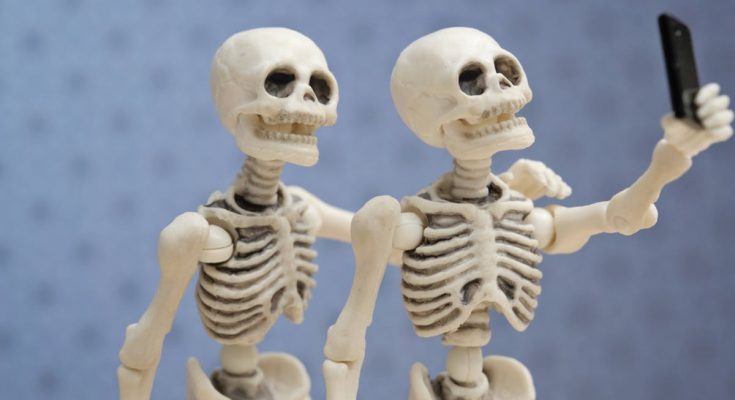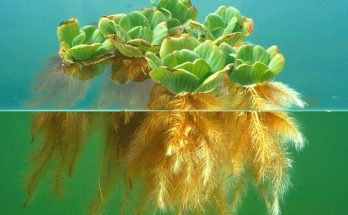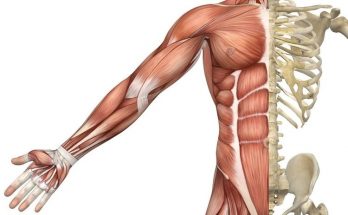Find the given statements are true or false.
- All organs work alone to perform different functions for the body. FALSE
Correction: All organ systems do not work alone in your body. They must all be able to work together.
- All joints in the body allow movement. FALSE
Correction: Joints that don’t move are called fixed. For example: the suture joints in the skull do not move.
- The backbone consists of one long bone. FALSE
Correction: The backbone is made up of 33 small bones known as vertebrae.
- The ball and socket joint allows movement in one direction only. FALSE
Correction: The ball and socket joints like hip and shoulder joints allow movement in all directions
- Muscles pull or push bones to make them move. FALSE
Correction: .Muscles can pull bones, but they can’t push them back to the original position.
- The bone marrow present inside the bones produces the WBCs. TRUE
Explanation: Bone marrow is the spongy tissue inside bones that produces blood cells. Bone marrow produces red blood cells, platelets, and white blood cells.
- Hinge joint is found in the knees. TRUE
- The humerus bone is present in the lower limb. FALSE
Correction: The humerus is the bone in your upper arm. It’s located between your elbow and your shoulder.
- The cardiac muscles are found in the wall of the heart.: TRUE
- A bent back puts burden on the backbone and joints : TRUE
Also Check – Bones And Muscles / The Skeletal System Class 5 Notes
Choose the correct option to fill in the blank.
- All the bones present in our body forms our (digestive/skeletal) system
- The bones of the limbs are (short/long)
- The (ribcage/skull) protects the brain.
- The delicate spinal cord is protected by (backbone/jawbone).
- The upper jaw (or/and) lower jaw has teeth.
- Bones are held together by (tendon/ligament)
- The human skeleton encloses and protects all the delicate organs of our body .
- The vertebral column protects the delicate spinal cord.
- The muscles which are not under our control are called involuntary muscles .
- The ligaments are the strong tissues which hold the bones together.
- The powerful atlas bone bears the weight of the whole body.
- Which muscle contracts when you raise your arm? Biceps
- Which muscle contracts when the arm is straightened? Triceps
- What attaches the arm muscles to the bone? Tendon
- Name the joint between the shoulder blade and bone of the upper arm. Ball and socket joint.
- An example of food rich in vitamin D is cow’s milk.
- The location where voluntary muscle is present is arms and legs.
- The location where the gliding joint is present is wrists and ankles
- The longest bone in the body is femur.
- The bone in the upper arm is humerus
- An example of calcium-rich food is cow’s milk.
Short answer questions –
1. Name the minerals present in our bones.
Ans: The major minerals found in bone are calcium and phosphorus in the form of an insoluble salt called hydroxyapatite [chemical formula: (Ca)10(PO4)6(OH)2].
2. Define skeleton. Also, mention its role.
Ans: All the bones in our body form a framework to give a shape to our body. This framework is called the skeleton. Thus a skeleton is made up of many bones.
Role: The major functions of the skeletal system are :
- It is the internal body support framework so that we have a correct posture and shape.
- It facilitates movement of various parts of our body
- It protects the delicate and important internal organs.
E.g. The backbone protects the spinal cord and the skull protects the brain.
- Storage of minerals like calcium and fat
- The bone marrow present inside the bones produces the red blood cells. What is the function of ribcage?
Ans: The main function of the rib cage is that it protects the delicate internal organs like heart, liver and lungs.
3. What is a vertebra? Where is it present?
Ans: Vertebrae are the 33 individual, interlocking bones that form the spinal column. Each vertebra has three main functional components: the vertebral body for load-bearing, the vertebral arch to protect the spinal cord, and transverse processes for ligament attachment. It is present in the backbone of animals.
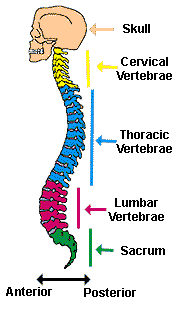
4. What do you understand by cartilage? Also, write its function.
Ans: Cartilage is a flexible connective tissue that keeps joint motion fluid by coating the surfaces of the bones in our joints and by cushioning bones against impact.
Function: The most important functions of cartilage include:
- Cartilage gives shape, support, and structure to other body tissues.
- It helps to cushion joints and acts as a buffer to any harmful impact or tear and wear.
- . Cartilage also smoothens the bone surfaces at the joints.
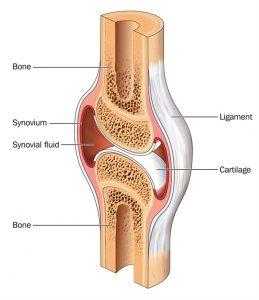
5. Write any two points related to the care of bones and joints.
Ans: To make our bones and joints strong and healthy, we should do the following:
: • Eat food items that are rich in proteins. Proteins help in the growth and repair of the body. They also help in building muscles. Food items that are rich in proteins are also called body-building foods. Young children need a greater protein-rich diet than adults to help in their growth and development.
Example: . Milk, eggs, cheese, fish, Some food items meat, beans, and pulses are good sources of proteins. that contain proteins
- Eat food items that are rich in calcium. It helps in the formation of bones and teeth. Some examples of calcium-rich foods are milk, curd, almond, and cheese. Read More Short Question Answers of The Skeletal System
Long answer questions.
1. Write about the major bones present in our body.
Answer – The skeleton consists of the skull, backbone, ribcage, limbs, jawbone, and girdle bones.
-
Skull:
The skull is a hollow, round structure present in the head.
Structure of skull
It is made up of 22 bones, of which eight bones form the part of the skull (that protects the brain) and the remaining 14 bones form the face. In addition, there are six small bones in our ears: three in each ear. All the bones of the skull are fixed and immovable, except the lower jaw.The lower jaw is joined to the upper jaw.The upper and lower jaws have teeth.
Functions of skull
- The skull covers and protects the brain.
- It also gives shape to the face. The movable lower jaw helps us to talk and eat (teeth).
- Jawbone The jawbone is the U-shaped bone of the lower jaw.
Structure of jawbone
It is the largest and strongest bone in the skull. It is the only bone in the skull that can move.
Function of jawbone :
It helps us to move our mouth so that we can chew food.
-
Backbone
.The backbone is a long and flexible bony structure, It is also known as the vertebral column or spine
It is connected to the base of the skull at its top.
Structure of backbone:
It is made up of 33 small, ring Iike bones. The individual small bones are called vertebra. The delicate spinal cord passes through them.
Function
The backbone encloses and protects the delicate spinal cord.
-
Ribcage
The ribcage is a bony structure present in the chest region.
Structure of ribcage :
It is made up of 12 pairs of thin, curved bones called ribs.
A long, flat bone, called the sternum, is present at the center of the chest and holds these ribs together in the front.
At the back, the ribs are held together by the spine or backbone.
However, the last two pairs of ribs are not attached to the sternum. These two pairs of ribs are called the floating ribs.
Function of ribcage:
The ribcage protects the delicate organs such as the heart and the lungs.
-
Limbs
Human beings have four limbs: a pair of upper limbs (arms) and a pair of lower limbs (legs),.
Upper limbs:
Upper limbs have two parts: the upper arm and the lower arm. The bone present in the upper arm, called humerus, is joined to the two bones of the lower arm at the elbow region, radius and ulna.
Function of upper limbs
Its bones along with muscles and joints , causes movement of arms, and thus helps in doing activities well as as eating, writing and lifting things.
Lower limbs:
The lower limb consists of the thigh (the upper leg), the leg (the lower leg), and the foot.
The thigh consists of a single bone, the femur which is the largest bone in the body.
The leg consists of two long bones, the tibia and fibula, and the sesamoid bone, the patella, that serves as the knee cap.
The foot consists of 26 bones, which are grouped into the tarsals, metatarsals, and phalanges.
Functions of lower limbs:
Its bones along with muscles and joints, causes movement of legs, and thus helps to walk, and run.
-
Girdles:
A girdle is a bony, ring-like structure.
There are two girdles present in our body:
the shoulder girdle and the hip girdle,
The shoulder girdle is made up of the shoulder blade and the collar bone.
The hip girdle is made up of three bones fused to form a single bone.
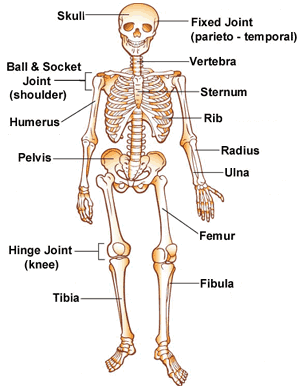
2. What are the major functions of bones in the human body?
Answer 2 : The main functions of the bones that form the skeleton are listed as follows.
Shape and support: It gives shape and support to the body.
Protection: It protects the delicate internal organs such as the brain, spinal cord, heart, and lungs.
Movement: It allows the movement of the various ports of the body.
Production and storage: Bone marrow present inside the bones produces the red blood cells. The bones of the skeleton also store the mineral calcium. Read More Long Question Answers Of Bones and Muscles / The Skeletal System
